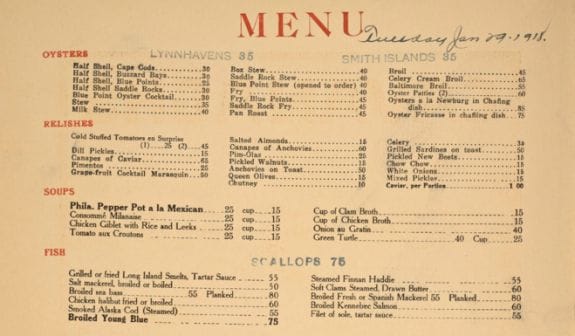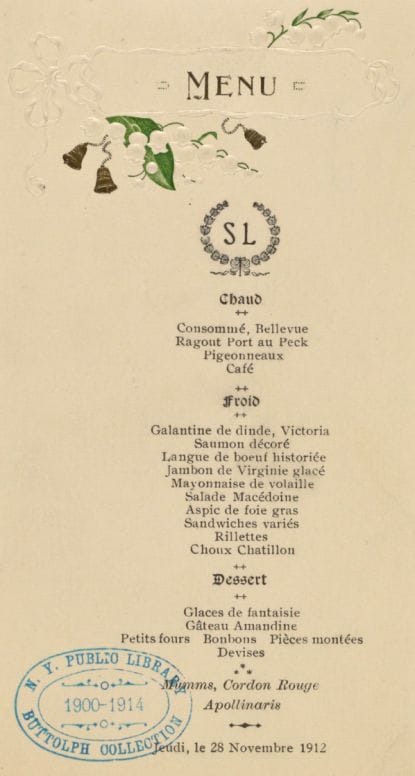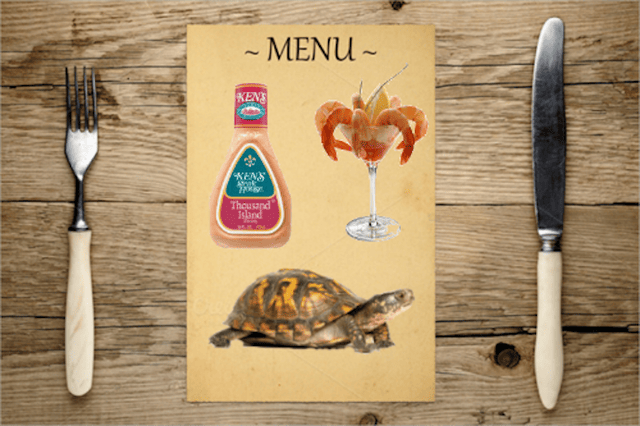
Turtle was once commonplace on the menus of American restaurants. A restaurant goer would not have been surprised to find a choice between turtle soup and turtle steaks, or having their turtle (or “cooter” to aficionados) cooked in the Creole, Baltimore or English style.
But no longer. Turtle, the favored meat of many presidents, is now rarely found on American menus. Due to overhunting and the difficulties of factory farming the animal, today’s turtle meat lovers are out of luck. The following chart, using data from the New York Public Library’s menu dataset, demonstrates the disappearance of turtle dishes from American menus.
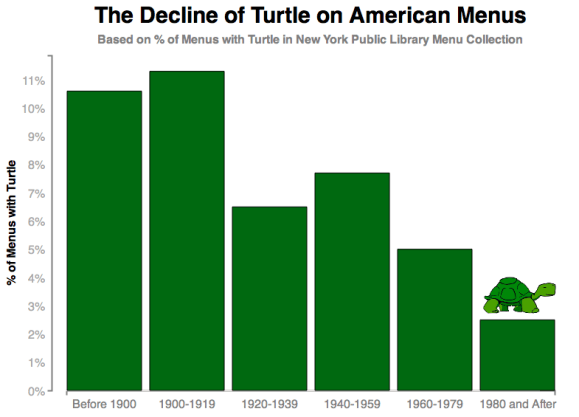
Dan Kopf, Priceonomics; Data: New York Public Library
Whereas over 11% of menus from 1900 to 1919 contain a turtle dish — mock turtle, also popular at the time, is excluded — this is true of only 2.5% of menus from 1980 onwards. It’s likely even rarer today.
American menus change fast. It’s not just turtle; many of the items most popularly found on menus a hundred years ago (like frizzled beef and biscuit tortone) are unknown today.
We used the New York Public Library’s menu dataset, which consists of information from thousands of menus from 1851 until today, to identify the most distinctive dishes of different time periods. The results offer a fun glimpse into America’s culinary past, and a reminder of the ephemerality of cuisine.
The first page of the menu for the restaurant Cavanagh’s from 1918.
The New York Public Library began collecting menus in 1900. According to the Library, the collection now contains approximately 45,000 menus of “graphic, gastronomic, topical or sociological interest.” Access to these menus is a boon to those hoping to understand culinary trends like chefs, historians and novelists. And now, for the data analyst as well.
In 2011, the Library began digitizing and and transcribing these menus. Today, thanks to the efforts of thousands of volunteers, more than 17,000 menus with well over a million dishes have been transcribed, and the data is publicly available. The dataset is not a perfectly random sample of all American menus — pricier restaurants, and those from the New York area, are overrepresented. But it is by far the best historical menu data available, and it’s full of interesting nuggets.
So what can we learn from these menus? Mostly, that tastes have changed.
The following table shows the most distinctively popular dish during each decade (drinks are excluded). Distinctively popular is defined as the dish that shows up on the most menus in that period in comparison all other periods. Menus from after 1980 are sparse, so we made 1980 to the present its own time period. Each time period includes at least 400 menus.

Data: New York Public Library
3.4% of the menus in the dataset from prior to 1900 include the dessert pieces montees, an “elaborate” cake made of “assembled pieces”. But the dish is found on less than a tenth of a percent of 20th Century menus. The prevalence of this extravagant dish is a reminder that restaurants have historically been a luxury. One of the last appearances of pieces montees in the dataset is from 1912 (menu below).
Chopped chicken livers, most distinctive to the 1950s, is a great example of a food that was particular to its time. Listed on 5.4% of menus in the fifties, it is on less than 0.6% of menus from other time periods. The last time it appeared on a menu in this dataset is 1985. Eating organ meats seems to have went out of style towards the end of the 20th Century.
***
Looking at the most uncommon dish by decade did not satiate our menu data analysis desires, so we dove further into the dishes unique to different eras. We identified the ten most unusually popular dishes for the following periods: Before 1900, 1900-1919, 1920-1939, 1940-1959, 1960-1979 and after 1980. Let’s walk through the data chronologically.
First, the distinctive dishes from before 1900. Six of the ten unusually popular dishes prior to 1900 are in French. We did not go through the process of translating dish names, but this has the benefit of demonstrating the dominance of French cuisine in 19th Century America. All of these dishes appear on at least thirty menus.

Data: New York Public Library
Mottoes, glaces fantaisies, and gateaux assortis are all French desserts. huitres is French for oysters and salade de laitue for lettuce salad.
English snipe, a bird considered a delicacy in the 19th Century, last appears on a menu in the dataset in 1914. In an 1890 cookbook, Allessandro Fillippinni, a chef at the popular Delmonico’s restaurant in New York, writes that to serve broiled English Snipe the cook should, “Prepare a hot dish with six toasts, arrange the snipe over, spread a gill of maitre d’hotel butter on top, decorate the dish with a little watercress, and serve.” Perhaps those instructions made sense at the time.
The dishes unique to the period of 1900-1919 are actually almost entirely in English.
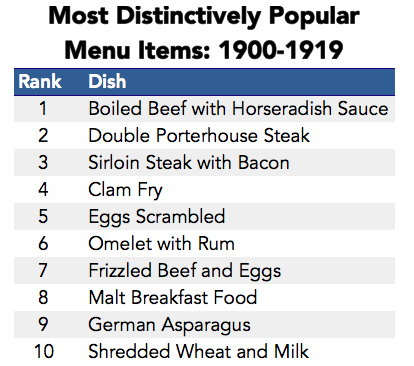
Data: New York Public Library
Boiled beef with horseradish sauce, an Austrian specialty, and Double Porterhouse Steak both appeared on 33 different menus from 1900-1919, but in no other era. The New York Times called number six on this list, omelet with rum, an “obscure hidden gem [from the] 19th Century.” The dish, last on a menu in the dataset in 1914, was lit aflame before being served.
Terrapin Maryland, a species of turtle, just missed the list. According to the aforementioned chef Alessandro Filippini, terrapin Maryland is best eaten with pepper, nutmeg and a “glassful of madeira wine.”
The list of the most unusually popular dishes from 1920 to 1939 is a bit more tame.
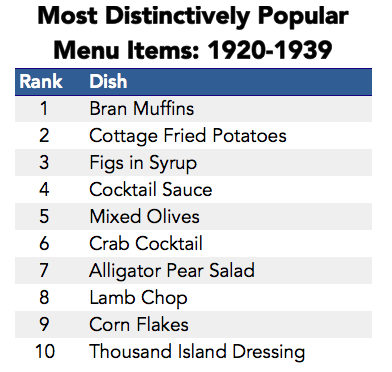
Data: New York Public Library
Apparently the 1920s and 1930s were the heyday of the bran muffin. At that time, it was a common alternative to toast. The image below is a snippet from the 1938 menu for a restaurant called the Milwaukee Road.
Thousand Island dressing first appears on a menu in the dataset in 1913. The origins ofThousand Island—mayonnaise combined with ingredients such as olive oil and vinegar—are debated, but the mixture seems to have been created around 1900. The quick rise of the dressing on the menus of fine American restaurants shows that, even in the early parts of the twentieth century, food fads spread fast. Thousand Island dressing was the Sriracha of its time.
The most distinctive dishes for the period of 1940 to 1959 is led by another food fad.
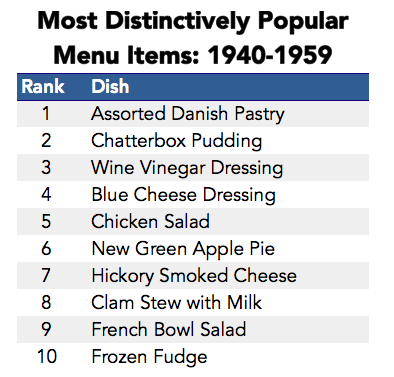
Data: New York Public Library
Danish pastry, a kind of puff pastry made with “laminated” dough, was hugely popular in mid century New York City, and it spread to the rest of the country. Assorted Danish Pastry, found on more than twenty menus in between 1940 and 1959, is found on no menus from other periods. A 1962 New York Times obituary for the New York restaurant owner Herman Gertler explains:
At one point during his career Mr. Gertner befriended a Danish baker who convinced him that Danish pastry might be well received in New York. Mr. Gertner began serving the pastry in his restaurant and it immediately was a success.
Danish pastry can still be found in bakeries across the United States, but it is no longer common at sit down restaurants.
Chatterbox pudding, a dish common to New York restaurants of the 1940s, is almost completely unknown today. The dish, which seems to be a combination of boiled pudding with bread or sponge cake, is of unknown origin and has culinary historians “scratching their heads.”
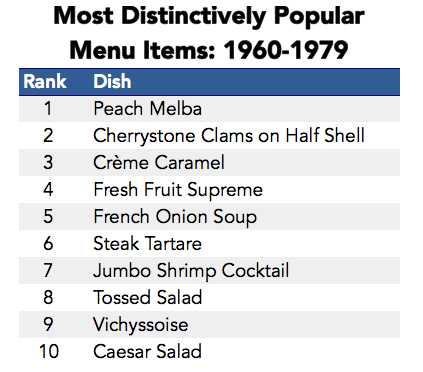
Data: New York Public Library
The 1960s and 70s were a time of new desserts and all things French.
Peach melba, a dessert made up of peaches, vanilla ice cream and raspberry sauce, was big in the 1960s. Of menus in the dataset from the 1960s, peach melba is found as frequently as orange juice and mashed potatoes. Today, it’s a rarity. It appears on only one menu after 1985. Apparently, if you want peach melba, look to a cruise ship, the last stop for dying foods.
French onion soup was at its most popular in the 1960s. The dish’s popularity in this period is related to the resurgent popularity of french cooking. Julia Child was a proponent of the dish.
The last table shows the most distinctively popular dishes from 1980 to today. A number of the foods most associated with contemporary American cuisine make the list.
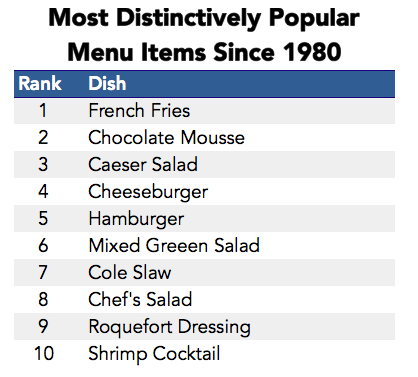
Data: New York Public Library
Though originating in Europe, french fries have become the great modern American dish. The First Lady has spoken of her “obsession” with the dish, and they are the image most associated with today’s fast food eating culture. The appearance of french fries at the top of the list also demonstrates the democratization of “eating out”. The restaurants in the dataset from 1980 onwards are less likely to be out of the reach of middle class Americans.
The data suggest that the popular foods of today may be more more short lived than we expect. It may be hard to believe that french fries will ever not be as ubiquitous to menus as they are today. But menus evolve quickly. In the next several decades, the data suggests french fries, cheeseburgers and mixed green salad may just disappear from American menus. Just like peach melba and English snipe, foods we can’t imagine not being able to order may become relegated to the past.
***
Our next post explores the origins of the term “Type A personality.” To get notified when we post it → join our email list.
This post was written by Dan Kopf; follow him on Twitter here.




